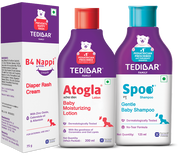

The New Parent’s Guide to Bathing Your Baby
2023-08-15 - Tedibar Body Wash
Blog Summary
Baby Skin
There is nothing as precious, and as delicate, as a newborn. Which is why, as a new parent, giving your baby a bath might seem frightening. But with the right guidance and a little practice, you'll become an expert in no time. Let’s take a look at a few simple guidelines set by the Indian Academy of Paediatrics (IAP) for your newborn baby's first bath.
When should newborns get their first bath?
According to the Indian Academy of Paediatrics, the first bath should be delayed until 24 hours after birth. Sometimes, this may not be possible due to cultural reasons, in which case the bath can be given after at least 6 hours have passed. The duration of the bath should be 5–10 minutes, and no longer than 10 minutes.
Once the first bath is over, you can begin bathing your baby twice a week or as needed. Bathing can be a wonderful opportunity to bond with your newborn. Talk to your baby in a soothing voice, maintain eye contact, and reassure them with your touch. Sing lullabies or play gentle music to create a serene and calming environment. This will help your little one associate bath time with love and warmth.
Here are some simple steps on how to bathe your newborn baby that will help you create the perfect warm and cuddly bathing experience.
How to bathe a baby
Step 1: Gather the essentials
Before you begin, gather everything you need within arm's reach. This includes a basin or a baby bathtub, lukewarm water, soft washcloths, mild baby soap and fresh clothes. Keep in mind that you should never leave your newborn baby unattended during the bath.
Step 2: Maintain a cosy environment
Ensure that the room is comfortably warm to prevent your little one from feeling chilly. A temperature between 24–26°c is ideal. Close the windows and doors to avoid drafts, and make sure the bathing area is clean and clutter-free.
Step 3: Test the water temperature
The water should be the perfect temperature, neither too hot nor too cold. The ideal temperature for your baby's bath is around 37–37.5°c. Use your elbow or a bath thermometer to check the water temperature before placing your baby in the tub. It's always better to err on the side of caution and have a slightly cooler bath than a hot one. Remember, baths that are too hot can cause dryness.
Step 4: Gently cleanse
Time to get started! Gradually lower your little one into the water, supporting their neck and head throughout. Use a soft washcloth and a mild baby soap, such as Tedibar bathing bar, to gently clean their delicate skin. Start with their face, followed by the neck, chest, arms, and legs. Pay special attention to the folds of the skin, but be gentle to avoid any irritation.
Step 5: Shampoo and rinse
Support your baby’s head with one hand and use a mild baby shampoo to gently cleanse their hair. Be careful not to let the shampoo get into their eyes. Rinse their hair by slowly pouring water over their head. Ensure that no soap or shampoo residue remains on their skin.
Step 6: Dry and dress
Lift your baby out of the water and immediately wrap them in a soft towel, gently patting them dry. Take your time to thoroughly dry all the little creases and folds of their skin. Remember, excess moisture can cause rashes and irritation, so be carefOnce dry, dress your baby in fresh clothes, ensuring that they are comfortable and warm. Don't forget to put on a clean diaper!
Bathing your newborn is a beautiful experience that creates a strong physical and emotional bond. By following this simple baby bath procedure, you can create a warm and cuddly bathing routine for your precious little one. Remember, every baby is unique, so feel free to adapt these steps to suit your baby's needs.
Sensitive Skin
Skincare Notes & Tips
- Your baby’s skin and immune system are sensitive, so it’s important to adopt a skincare routine to shield your little one’s skin from germs.
- Newborn babies have naturally wrinkly skin coated in vernix, a waxy covering that peels off on its own after a while.
- Avoid rubbing off the vernix or slathering lotion over it; when it comes to basic newborn skincare, follow the golden ‘less is more’ approach.
- Diaper rashes are common amongst babies; to avoid them, clean your baby’s bottom with warm water at each change, and let the area dry before putting on another diaper.
- Diaper rashes do not normally warrant medical attention, but if they do not clear up in two to three days, consult a dermatologist. Wash your baby’s clothes, bedding and blankets separately with mild, fragrance-free and dye-free detergents.
- Massage your baby daily; studies have shown that babies thrive on touch and that babies massaged daily cry less often, feel loved and sleep longer.
Bathing Notes & Tips
Bathing Notes & Tips
- You might notice that your baby enjoys splashing in bath water, but try to keep baths short and sweet to avoid drying your baby’s skin.
- Use mild, baby-friendly soap during bath time and make sure not to rub the soap on your baby’s skin too harshly, as this can dry it out.
- Keep bath water lukewarm
Moisturise your baby’s skin with fragrance-free baby lotion after each bath. - Restrict baths to two to three times a week; bathing your baby too often can cause their skin to dry out by stripping it of natural oils.












